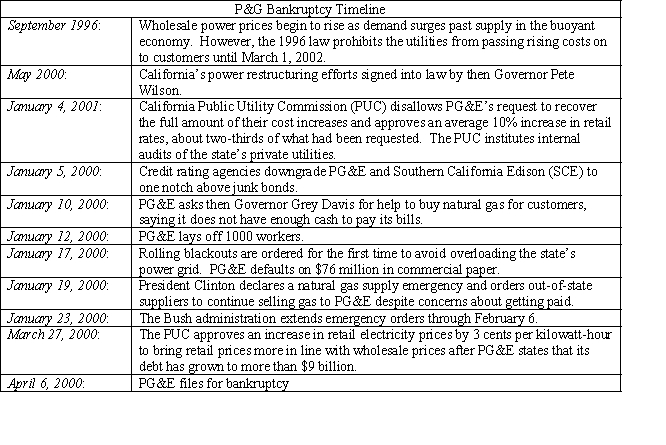PG&E SEEKS BANKRUPTCY PROTECTION
Pacific, Gas, and Electric (PG&E), the San Francisco-based utility, filed for bankruptcy on April 7, 2001, citing nearly $9 billion in debt and un-reimbursed energy costs. The utility, one of three privately owned utilities in California, serves northern and central California. The intention of the Chapter 11 reorganization was to make the utility solvent again by protecting the firm from lawsuits or any other action by those who are owed money by the utility. The bankruptcy will also allow the utility to deal with all of the firm's debts in a single forum rather than with individual debtors in what had become a highly politicized venue. The following time line outlines the firm's road to bankruptcy.  .
.
Utility industry analysts saw PG&E's move as largely an effort to escape the political paralysis that had befallen the state's regulatory apparatus. The bankruptcy filing came one day after Governor Davis dropped his opposition to raising retail rates. However, the Governor's reversal came after five month's of negotiations with the state's privately owned utilities on a rescue plan.
PG&E's common shares fell 37 percent on the day the firm filed for reorganization. Fearing a similar fate for San Diego Gas and Electric, the shares of Sempra Energy, SDG&E's parent corporation, also dropped by 35 percent
In an attempt to insulate California ratepayers from escalating wholesale electricity prices, the state entered into a series of 5-to-10 year contracts with electricity power generators that account for more than two-thirds of the state's projected power needs. The last contracts were signed by the state in June 2001. By September, a slowing economy pushed the wholesale price of electricity well below the level the state was required to pay in the "take or pay" contracts the state had just signed. Estimates suggest that California taxpayers will have to pay between $40 and $45 billion in power costs over the next decade depending on what happens to future energy costs. PG&E has continued to supply its customers without disruption or blackout while being under the protection of the bankruptcy court.
Southern California Edison, nearing bankruptcy for reasons similar to those that drove PG&E to seek protection from its creditors, reached agreement with the Public Utility Commission to pay off $3.3 billion in debt owed to power generators from customer revenues. Previously, the PUC had forbid the utility to use monies generated from two previous rate increases for this purpose. The U.S. District Court judge approved the plan on October 5, 2001. While some creditors complained that the settlement was not reassuring because it did not include a timetable for repayment of outstanding debt, others viewed the agreement as a voluntary reorganization plan without going through the expensive process of filing for bankruptcy with the federal court.
:
-In your judgment,did regulators attenuate or exacerbate the situation? Explain your answer.
Definitions:
Long-Term Debt
Long-term debt refers to loans and financial obligations lasting over one year that a company owes and is recorded on its balance sheet.
Long-Term Debt Ratio
A financial ratio that measures the proportion of a company's total debt that is due more than one year in the future.
Common-Base Year Value
A method used in economics and financial analysis to adjust values for comparison by fixing the prices of goods and services to a specific base year, neutralizing the effect of inflation.
Accounts Receivable
Funds that customers owe to a company for products or services they have received but have not yet compensated for.
Q8: A research problem is<br>A)a problem that needs
Q11: Which of the following is a procedural
Q15: As you examine a published research report,you
Q18: List the five sections typically found in
Q22: At which step in the research process
Q24: Arbitrage should drive the prices in different
Q24: Why do you think the parents opted
Q25: Which one of the reasons below is
Q34: The court must approve any plan accepted
Q40: Bankruptcy is a state-level legal proceeding designed